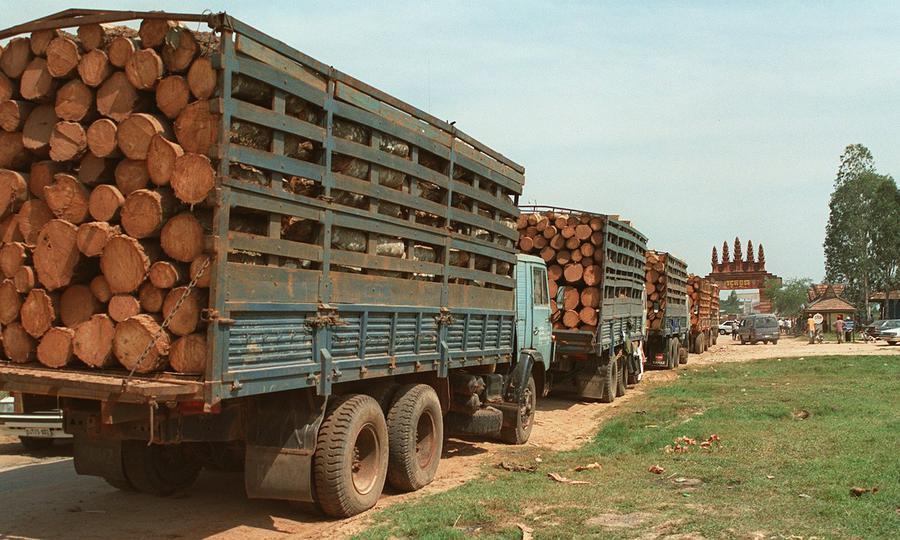
Deforestation warming Cambodia, activists say
(MENAFN- Asia Times) As the impacts of climate change become more apparent worldwide, members of the public are connecting more weather events to the phenomenon.
In March and April, for example, extreme heat baked mainland Southeast Asia. On April 20, Vietnam set an all-time observed record high temperature , 43 degrees Celsius (110 degrees Fahrenheit), and neighboring Cambodia suffered as well. This led to public criticism there that deforestation in the country has contributed to elevated temperatures.
The Cambodian government, however, has rejected these critiques.
'Deforestation in Cambodia has not contributed to higher temperatures in the country,' Neth Pheaktra, a spokesperson for the Ministry of Environment, said in a WhatsApp message earlier this month. 'The rise of temperatures in the country is caused by global warming, which is mostly contributed to by developed countries with heavy industries.'
He also cited research by the Intergovernmental Panel on Climate Change (IPCC), which found that the energy and industry sectors contribute 74% of global greenhouse-gas emissions, while forestry and land-use changes account for far less.
'Cambodia's forest has only 9 million hectares,' about 22 million acres, Neth added, 'compared with 4 billion hectares [10 billion acres] in the world. So, deforestation in Cambodia has not affected global warming.'
Thibault Ledecq, regional conservation director at the WWF-Greater Mekong, was more cautious about connecting the two trends. 'According to literature, climate change has an indirect effect on the forests in the Mekong region, influencing productivity and progression, flowering periods, growth, species, etc.,' he said in an email.
'On the other hand, deforestation also contributes to climate change through increased emission of CO2 and reduced sequestration, as well as through potential effects of changes in water cycles. The effects may be global or local, but we don't have sufficient evidence to link deforestation directly to temperature rise at a country level.'
Cambodia's deforestation epidemic

A drone photo shows a gold mine site and surrounding forest and farmland. Image courtesy of Mother Nature Cambodia
Nonetheless, Cambodia does provide a strong test case to determine a possible link between deforestation and climate change.
'Cambodia has had one of the highest deforestation rates in the last few decades, which has significantly contributed to global climate change,' Ledecq said. 'Forested area in Cambodia declined 4.6% per year from 2010 to 2014 according to the country's government report available through the Regional Forest Observatory – Southeast Asia.'
As previously reported by Mongabay , Cambodia's forests face acute threats from deforestation, despite a logging export ban and reported crackdowns on the illegal timber trade. Vietnam, in particular, is a major consumer of illegally imported Cambodian timber.
Neth further attributed deforestation to demand for timber from both domestic and foreign markets, conversion for agricultural land, and infrastructure development.
He also said the Cambodian government was taking numerous measures to combat deforestation, including 'orders from the prime minister to protect forests and eliminate illegal logging and land encroachment' and reforms to differentiate government roles related to conservation and development.
According to Ledecq, however, ineffective forest protection and land-use policies have contributed to the country's huge deforestation problem.
The science between deforestation and heat

Pink shield bug in Cambodia. Photo by Rhett A. Butler / Mongabay
While hard data on the relationship between deforestation in Cambodia and increased temperatures has not been established yet, a recent study on this topic at a global scale, with a focus on Brazil, provides evidence that can't be ignored.
In their abstract, the report's authors state that 'changing forest cover is a key driver of local climate change worldwide, as it affects both albedo [the ratio of solar radiation that's reflected away] and evapo-transpiration.'
According to the North Carolina Climate Office , based at North Carolina State University, albedo is 'a measure of how much light that hits a surface is reflected without being absorbed.'
As indicated in the study, forests absorb much of the sunlight that hits them. Non-forested areas, including concrete-heavy urban or industrial areas that often replace forests in developing nations, reflect sunlight, creating more heat at ground level.
Evapo-transpiration , meanwhile, is 'the process of evaporating water from leaves through plant transpiration during photosynthesis,' according to the climate office. This is responsible for 15% of all water vapor in the atmosphere. Fewer trees means less water vapor, which makes it harder for clouds to form. In turn, this leads to less precipitation and higher temperatures.
While the report is highly technical and doesn't include data specific to Cambodia, Ledecq offered insight into what the findings could mean for the country.
'The study finds that globally on average deforestation led to consistent warming in the tropical and temperate regions, with temperatures raising by 0.36-0.40 degrees Celsius [0.65 to 0.72 degrees Fahrenheit] and 0.15-0.17 degrees C [0.27 to 0.31 degrees Fahrenheit], respectively,' he said. 'Forestation had the opposite effects in those same regions, with temperatures cooling by about 0.2 degrees C [0.36 degrees Fahrenheit] over the study period [2000-2010].'
Meanwhile, higher deforestation rates were found to create even more intense warming, with 50% rates of forest cover loss in tropical areas leading to warming of 0.8 to 1.3 degrees Celsius (1.5 to 2.4 degrees Fahrenheit).
'The global forest cover dataset used in this study is often said to be not very accurate for Cambodia because of different forest ecosystem there,' Ledecq said. 'This means that simple extrapolation may under- or over-estimate the effects of forest cover change on the local climate in Cambodia specifically. Nevertheless, the evidence is pretty compelling that the same ecological mechanism is at work in Cambodia.'
Jayme Prevedello, one of the report's authors, agreed in an email response. 'Unfortunately, we did not analyze the data for each country separately [except Brazil],' he said. 'However, as Cambodia is within the tropical zone as defined in our paper, I believe the patterns are similar as those of other tropical areas, including Brazil.'
This story appeared first on Mongabay.com; the original report can be accessedhere
Sign up for the Daily Report

Legal Disclaimer:
MENAFN provides the
information “as is” without warranty of any kind. We do not accept
any responsibility or liability for the accuracy, content, images,
videos, licenses, completeness, legality, or reliability of the information
contained in this article. If you have any complaints or copyright
issues related to this article, kindly contact the provider above.

















Comments
No comment